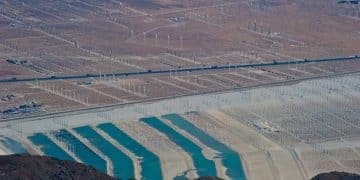Long-Term Economic Benefits of Investing in Renewable Energy in the US

Investing in renewable energy infrastructure in the US offers long-term economic benefits such as job creation, reduced energy costs, enhanced energy security, improved public health, and decreased environmental impact, fostering sustainable growth.
Investing in renewable energy infrastructure is not just an environmental imperative; it’s a strategic economic move. Understanding what are the long-term economic benefits of investing in renewable energy infrastructure in the US requires a look at job creation, energy security, and cost savings.
Job Creation and Workforce Development
One of the most immediate and significant economic benefits of investing in renewable energy infrastructure is the creation of jobs. These jobs span various sectors, from manufacturing and construction to installation, maintenance, and research.
The renewable energy sector is inherently labor-intensive, requiring skilled workers for the development, deployment, and upkeep of renewable energy systems.
Manufacturing and Construction Jobs
The construction of solar farms, wind turbines, and hydroelectric plants generates numerous jobs in manufacturing and construction. These roles include engineers, technicians, construction workers, and project managers.
Additionally, the manufacturing of components such as solar panels, wind turbine blades, and energy storage systems further boosts the domestic job market.
Installation and Maintenance Jobs
Beyond construction, the installation and ongoing maintenance of renewable energy systems create long-term employment opportunities. These jobs often require specialized training and skills, fostering the development of a skilled workforce.
Technicians, electricians, and maintenance personnel are needed to ensure the efficient operation and longevity of renewable energy facilities.
- Increased job opportunities across various sectors.
- Development of specialized skills and training programs.
- Contribution to local economies through job creation and wages.
The growth of the renewable energy sector not only creates jobs directly within the industry but also stimulates economic activity in related sectors. This ripple effect contributes to overall economic growth and stability.

Energy Security and Independence
Investing in renewable energy infrastructure enhances energy security by diversifying the energy supply and reducing dependence on fossil fuels. Renewable energy sources, such as solar, wind, and hydro, are domestically available and less susceptible to geopolitical instability.
By transitioning to renewable energy, the US can decrease its reliance on imported fuels, thereby mitigating the risks associated with global energy markets.
Reducing Reliance on Fossil Fuels
Fossil fuels are subject to price volatility and supply disruptions due to geopolitical factors. Renewable energy sources offer a stable and predictable alternative.
Decreased dependence on fossil fuels also reduces the environmental consequences associated with their extraction, transportation, and combustion.
Diversifying Energy Sources
Diversifying the energy mix with renewable sources enhances the resilience of the energy system. A diversified portfolio can withstand disruptions to any single energy source.
Renewable energy sources are distributed geographically, reducing the risk of concentrated energy infrastructure being vulnerable to natural disasters or other disruptions.
- Enhanced energy independence and security.
- Reduced exposure to volatile fossil fuel markets.
- Increased resilience of the energy system.
Investing in renewable energy infrastructure strengthens the nation’s energy independence and protects against vulnerabilities in the global energy market. This increased energy security contributes to long-term economic stability.
Cost Savings and Energy Efficiency
Renewable energy investments lead to long-term cost savings by reducing energy costs for consumers and businesses. While the initial investment in renewable energy infrastructure can be substantial, the operational costs are generally lower compared to fossil fuel-based energy systems.
Renewable energy sources require little to no fuel, which eliminates fuel price volatility and ongoing fuel costs.
Decreased Energy Bills
Renewable energy systems can significantly lower electricity bills for homeowners and businesses. Solar panels, for example, generate electricity at no fuel cost, reducing reliance on grid electricity.
Net metering policies allow consumers to sell excess electricity back to the grid, further reducing their energy expenses.
Operational Cost Reduction
The operational costs of renewable energy facilities are typically lower than those of fossil fuel power plants. Renewable energy systems have fewer moving parts and require less maintenance.
The absence of fuel costs also contributes to reduced operational expenses and greater cost predictability.
- Lower energy bills for consumers and businesses.
- Reduced operational costs for energy facilities.
- Increased energy efficiency and conservation.
By lowering energy costs and enhancing energy efficiency, renewable energy investments provide long-term cost savings and improve the competitiveness of businesses. These savings contribute to a more robust and sustainable economy.

Public Health Improvements
Transitioning to renewable energy sources leads to significant public health improvements by reducing air and water pollution associated with fossil fuel combustion. Cleaner air and water contribute to lower rates of respiratory illnesses, cardiovascular diseases, and other health problems.
The health benefits of renewable energy investments translate into reduced healthcare costs and improved quality of life for communities.
Reduced Air Pollution
Fossil fuel power plants release pollutants such as sulfur dioxide, nitrogen oxides, and particulate matter, which contribute to respiratory illnesses and cardiovascular diseases. Renewable energy sources produce little to no air pollution.
By reducing air pollution, renewable energy investments improve air quality and decrease the incidence of pollution-related health problems.
Improved Water Quality
Fossil fuel extraction, transportation, and combustion can contaminate water resources. Renewable energy sources, such as solar and wind, require little to no water for operation.
Transitioning to renewable energy protects water resources and reduces the risk of water pollution, benefiting both human health and ecosystems.
- Reduced incidence of respiratory illnesses and cardiovascular diseases.
- Improved air and water quality.
- Lower healthcare costs and enhanced quality of life.
The public health benefits of renewable energy investments are substantial, leading to healthier communities and reduced healthcare burdens. These benefits contribute to a more productive and sustainable workforce.
Environmental Sustainability
Investing in renewable energy infrastructure is essential for mitigating climate change and promoting environmental sustainability. Renewable energy sources produce little to no greenhouse gas emissions, helping to reduce the impact of climate change on the environment and economy.
Sustainable energy practices ensure the long-term health of ecosystems and the availability of natural resources for future generations.
Mitigating Climate Change
Greenhouse gas emissions from fossil fuel combustion are a major driver of climate change. Renewable energy sources offer a clean alternative that reduces carbon emissions.
By reducing greenhouse gas emissions, renewable energy investments help to slow the pace of climate change and mitigate its impacts on the environment and economy.
Preserving Ecosystems
Fossil fuel extraction and utilization can harm ecosystems and deplete natural resources. Renewable energy sources have a smaller environmental footprint and help to preserve ecosystems.
Sustainable energy practices protect biodiversity, conserve natural resources, and ensure the long-term health of the environment.
- Reduced greenhouse gas emissions and climate change impacts.
- Preservation of ecosystems and natural resources.
- Promotion of sustainable energy practices.
Environmental sustainability through renewable energy investments is crucial for safeguarding the planet and ensuring a prosperous future for all. These investments support a green economy and create opportunities for innovation and growth.
Technological Innovation and Economic Growth
Investment in renewable energy infrastructure spurs technological innovation and drives economic growth in the clean energy sector. Renewable energy technologies are constantly evolving, creating opportunities for research, development, and commercialization.
Innovation in renewable energy accelerates the deployment of clean energy solutions and improves their efficiency and affordability.
Research and Development
Funding for research and development in renewable energy technologies leads to breakthroughs and advancements that improve the performance and economics of renewable energy systems.
Research efforts focus on areas such as solar cell efficiency, energy storage technologies, and smart grid integration.
Commercialization and Deployment
Innovations in renewable energy create new business opportunities and drive the commercialization of clean energy technologies. Entrepreneurs and investors are drawn to the growing renewable energy sector.
Government policies and incentives support the deployment of renewable energy technologies and accelerate their adoption in the marketplace.
- Spurred technological innovation in the clean energy sector.
- Created new business opportunities and markets.
- Driven economic growth through commercialization and deployment.
Technological innovation in renewable energy fosters economic growth, creates high-paying jobs, and enhances the competitiveness of the US in the global clean energy market. These innovations contribute to a more sustainable and prosperous future.
| Key Benefit | Brief Description |
|---|---|
| 🛠️ Job Creation | Spurs jobs across manufacturing, construction, and maintenance. |
| 🛡️ Energy Security | Reduces reliance on volatile fossil fuels. |
| 💰 Cost Savings | Lowers energy bills due to minimal fuel costs. |
| ⚕️ Public Health | Improves air and water quality. |
Frequently Asked Questions
▼
The primary renewable energy sources in the US include solar, wind, hydro, geothermal, and biomass. Each source offers unique benefits and contributes to a diversified energy portfolio.
▼
Renewable energy investments can boost local economies by creating jobs, stimulating business opportunities, and increasing local tax revenues, fostering community development and resilience.
▼
Government policies, such as tax incentives, subsidies, and renewable energy standards, play a crucial role in promoting the development and deployment of renewable energy technologies.
▼
Energy storage technologies, such as batteries, help to address the intermittency of renewable energy sources by storing excess energy for later use, ensuring a reliable energy supply.
▼
Using renewable energy reduces greenhouse gas emissions, protects ecosystems, conserves natural resources, and mitigates the impacts of climate change, ensuring a healthier planet for future generations.
Conclusion
Investing in renewable energy infrastructure in the US offers a wide array of long-term economic benefits, from job creation and energy security to cost savings and public health improvements. By embracing renewable energy, the US can foster sustainable economic growth, enhance energy independence, and protect the environment for future generations.





